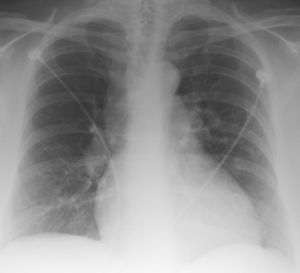Palla's sign

Editor-In-Chief: Prab R Tumpati, MD
Obesity, Sleep & Internal medicine
Founder, WikiMD Wellnesspedia &
W8MD medical weight loss NYC and sleep center NYC
| Palla's sign | |
|---|---|
 | |
| Synonyms | |
| Pronounce | |
| Specialty | Radiology, Pulmonology |
| Symptoms | Prominent pulmonary artery on chest X-ray |
| Complications | |
| Onset | |
| Duration | |
| Types | |
| Causes | Pulmonary embolism |
| Risks | |
| Diagnosis | Chest X-ray, CT pulmonary angiography |
| Differential diagnosis | |
| Prevention | |
| Treatment | |
| Medication | |
| Prognosis | |
| Frequency | |
| Deaths | |
Palla's sign is a radiological sign seen on a chest X-ray that indicates the presence of a prominent pulmonary artery, often associated with a pulmonary embolism. It is named after the radiologist who first described it. The sign is characterized by an enlarged right descending pulmonary artery, which can be seen as a prominent shadow on the X-ray image. This finding can help in the diagnosis of pulmonary embolism, a condition where one or more arteries in the lungs become blocked by a blood clot.== Palla's Sign ==
Palla's sign is a radiological sign seen on a chest X-ray that is indicative of pulmonary embolism. It is characterized by the enlargement of the right descending pulmonary artery, which can be observed as a prominent bulge on the X-ray image. This sign is named after the radiologist who first described it.
Clinical Significance[edit]
Palla's sign is considered a classic but not always present indicator of pulmonary embolism. It is one of several radiographic signs that may be observed in patients with this condition, alongside others such as Westermark's sign and Hampton's hump. The presence of Palla's sign can aid in the diagnosis of pulmonary embolism, especially when correlated with clinical findings and other diagnostic tests such as CT pulmonary angiography.
Pathophysiology[edit]
The appearance of Palla's sign is due to the increased pressure and volume in the pulmonary artery caused by the obstruction of blood flow. This obstruction is typically due to a thrombus (blood clot) that has traveled to the lungs from another part of the body, often the deep veins of the legs, a condition known as deep vein thrombosis (DVT).
Diagnosis[edit]
While Palla's sign can be a useful indicator, it is not sufficient on its own to diagnose pulmonary embolism. A comprehensive evaluation including clinical assessment, laboratory tests such as D-dimer levels, and imaging studies is necessary. Ventilation/perfusion scan and CT pulmonary angiography are more definitive tests for diagnosing pulmonary embolism.
Treatment[edit]
The treatment of pulmonary embolism involves anticoagulation therapy to prevent further clot formation and to allow the body to naturally dissolve the existing clot. In severe cases, thrombolytic therapy or surgical intervention may be required. The presence of Palla's sign does not alter the treatment plan but serves as a clue in the diagnostic process.
See Also[edit]
Ad. Transform your life with W8MD's Budget GLP-1 injections from $75


W8MD offers a medical weight loss program to lose weight in Philadelphia. Our physician-supervised medical weight loss provides:
- Weight loss injections in NYC (generic and brand names):
- Zepbound / Mounjaro, Wegovy / Ozempic, Saxenda
- Most insurances accepted or discounted self-pay rates. We will obtain insurance prior authorizations if needed.
- Generic GLP1 weight loss injections from $75 for the starting dose.
- Also offer prescription weight loss medications including Phentermine, Qsymia, Diethylpropion, Contrave etc.
NYC weight loss doctor appointmentsNYC weight loss doctor appointments
Start your NYC weight loss journey today at our NYC medical weight loss and Philadelphia medical weight loss clinics.
- Call 718-946-5500 to lose weight in NYC or for medical weight loss in Philadelphia 215-676-2334.
- Tags:NYC medical weight loss, Philadelphia lose weight Zepbound NYC, Budget GLP1 weight loss injections, Wegovy Philadelphia, Wegovy NYC, Philadelphia medical weight loss, Brookly weight loss and Wegovy NYC
|
WikiMD's Wellness Encyclopedia |
| Let Food Be Thy Medicine Medicine Thy Food - Hippocrates |
Medical Disclaimer: WikiMD is not a substitute for professional medical advice. The information on WikiMD is provided as an information resource only, may be incorrect, outdated or misleading, and is not to be used or relied on for any diagnostic or treatment purposes. Please consult your health care provider before making any healthcare decisions or for guidance about a specific medical condition. WikiMD expressly disclaims responsibility, and shall have no liability, for any damages, loss, injury, or liability whatsoever suffered as a result of your reliance on the information contained in this site. By visiting this site you agree to the foregoing terms and conditions, which may from time to time be changed or supplemented by WikiMD. If you do not agree to the foregoing terms and conditions, you should not enter or use this site. See full disclaimer.
Credits:Most images are courtesy of Wikimedia commons, and templates, categories Wikipedia, licensed under CC BY SA or similar.
Translate this page: - East Asian
中文,
日本,
한국어,
South Asian
हिन्दी,
தமிழ்,
తెలుగు,
Urdu,
ಕನ್ನಡ,
Southeast Asian
Indonesian,
Vietnamese,
Thai,
မြန်မာဘာသာ,
বাংলা
European
español,
Deutsch,
français,
Greek,
português do Brasil,
polski,
română,
русский,
Nederlands,
norsk,
svenska,
suomi,
Italian
Middle Eastern & African
عربى,
Turkish,
Persian,
Hebrew,
Afrikaans,
isiZulu,
Kiswahili,
Other
Bulgarian,
Hungarian,
Czech,
Swedish,
മലയാളം,
मराठी,
ਪੰਜਾਬੀ,
ગુજરાતી,
Portuguese,
Ukrainian